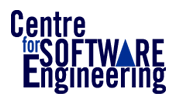
INTRODUCTION TO THE CSEThe CSE was established in 1990 by the most successful school of computing in Ireland, based in Dublin City University. It was sponsored by the Irish government and the European Union. The brief of the CSE is to direct and promote and support competence in IT operations in business and in the technology sector.The technology sector in Ireland is one of the most advanced in the world. Most of the largest multi-national technology companies have their European headquarters in Ireland. There is a high level of computer literacy in Ireland; this means that users of IT are demanding and are strong exploiters of IT. This level of use brings about greater efficiencies and management of business operations. The role of the CSE is to provide a range of assessment, strategic planning, training, and mentoring to the technology sector and to business enterprises and to government organisations to improve their IT capability to a strong international level. The most up-to-date international practices are employed. To ensure the quality of CSE services, personnel are engaged in research, in development of international standards, and development of CSE frameworks which are applied in its operation. Innovations in the CSE have included programmes with a cluster of companies that embark on major improvement drives. It includes a range of assessments, covering areas such as product quality, innovation capability, creativity, research and development operation, and business agility. Each programme includes a wide range of training and mentoring services. Services have been delivered to many companies across a wide range of business sectors, educational institutions, and government organisations. CLIENTSSome of the organisations where a significant range of services has been provided over a number of years:Ericsson is a major manufacturer of telecommunications networks with headquarters in Sweden; Fidelity is a major general insurance and investment management company with headquarters in the U.S. Siemens is a major engineering company and manufacturer of technology and is headquartered in Germany SSE Renewable is a major electric utility and is headquartered in the UK Sun Life is a major life insurance and investment management company and is headquartered in Canada Houghton Mifflin Harcourt (HMH) is a major publishing company in the U.S. Allied Irish Bank is the largest retail bank in Ireland Misys International is a major financial services technology company based in the UK Health Service Executive (HSE) is the provider of the public healthcare services in Ireland Kerry Group is a major international food processing company and the largest food company in Ireland EXAMPLES OF SERVICES PROVIDED INCLUDE:Improvement of processes in IT projects and in services delivery to provide consistency, productivity, quality and control.Development of technical and management skills to raise the competence of staff to address advances in technologies and products. Production of strategic plans to advance the adoption of new technologies and new applications, and contribute to the strategic direction of the enterprise. Introduction of innovation and knowledge management to lead to a competitive edge, and dynamic for change in the enterprise. PROPOSED CSE SERVICES:Building capability to achieve Leadership in Business through ITRANGE OF IT OPERATIONSInformation and Communications Technology (IT or ICT) is a core competence in advanced enterprises. When IT is very well developed in an enterprise, it contributes to the profit base, and it is regarded as an investment in the business.Key services provided by IT to the enterprise include:MASTER CLASSES AND RELATED SUPPORTS1. Function of CIO and Key Competences in ITThis service provides training courses and workshops to the IT Department senior personnel in the planning and management of the key functions in IT. It includes:
2. Technical Functions in ITThis service provides training courses and workshops to senior technical personnel in the IT Department to develop skills competence, excellent practices, and technical leadership. It includes:
3. Function of Business Executives in ITSuccessful enterprises are major exploiters of information technology. These technologies are constantly changing and new technologies are emerging. They provide a rich source of applications and business opportunities. These technologies are employed to bring about major advances, new business models and competitive strategies in the enterprise.
|
CSE International
Copyright © Centre for Software Engineering
Website: Red on Green Design
